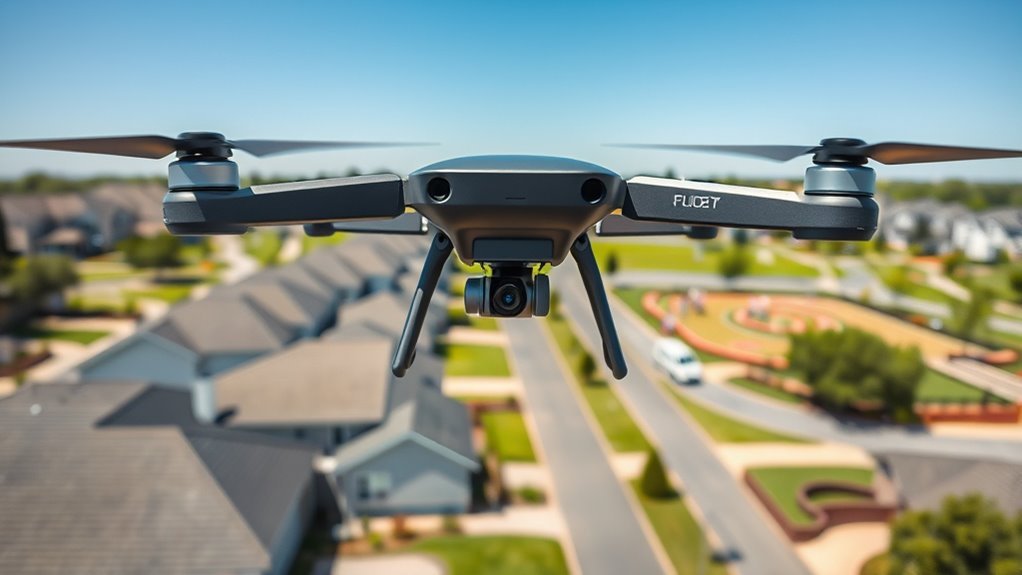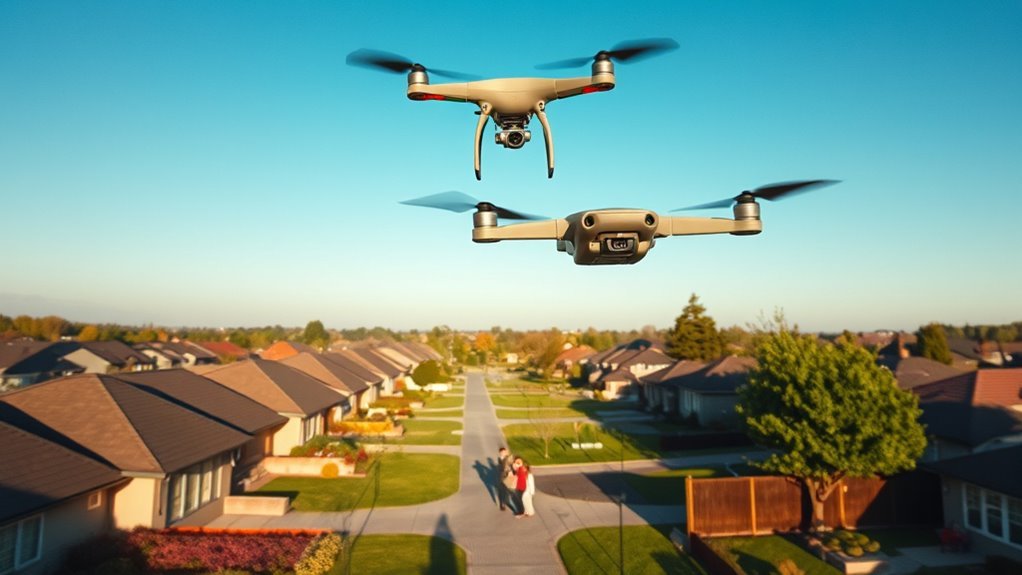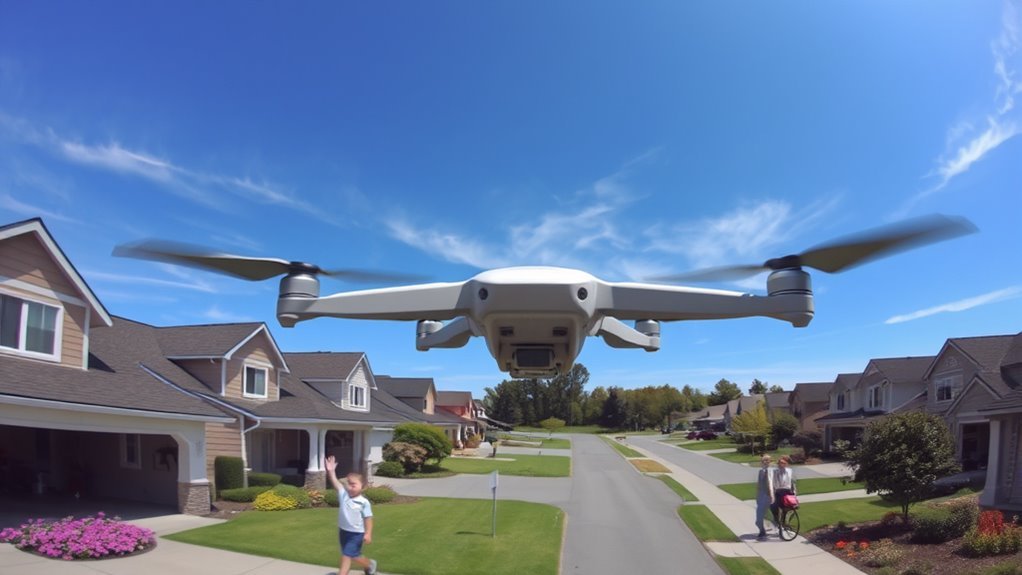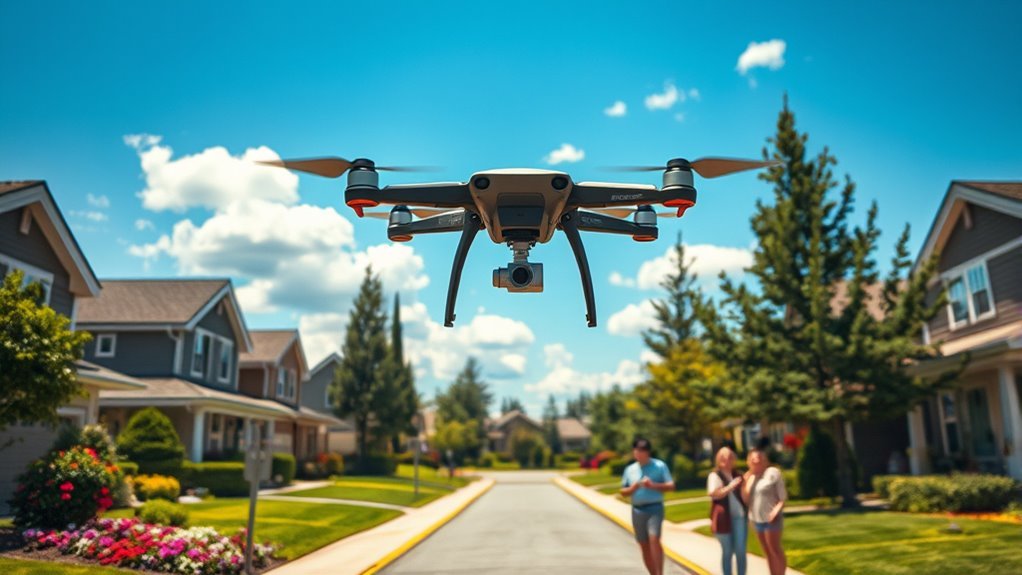To fly your drone legally around your neighborhood, you need to understand local regulations and register your drone if it weighs over 250 grams. Be aware of airspace classifications, respecting privacy rights, and maintaining a line of sight during flight. Avoid restricted areas, check weather conditions, and follow safety practices. Open communication with neighbors can enhance community relations. If you want to explore more helpful tips and regulations, there’s plenty more to discover.
Understanding Local Drone Regulations

Understanding local regulations is essential to guarantee compliance and avoid potential penalties. Each community has its own rules governing drone use, often enforced by local enforcement agencies. These regulations might include restrictions on flying in certain areas, altitude limits, and privacy considerations. To navigate these laws effectively, consider attending community workshops that provide valuable insights into your area’s specific requirements. These workshops often feature local experts who can clarify any confusing aspects of the regulations. Staying informed not only enhances your flying experience but also fosters a positive relationship with your neighbors, ensuring you can enjoy the freedom of flying your drone without any legal hassles. Additionally, ensure that you are aware of the mandatory registration requirements for drones over 250 grams to avoid any legal complications. Understanding the legal regulations ensures that you can fly safely and responsibly within your neighborhood.
Registering Your Drone

When you’re ready to register your drone, it’s essential to understand the specific requirements set by the FAA. You’ll need to gather pertinent information, such as your drone’s make, model, and serial number. Completing the registration process correctly guarantees you’re flying legally and responsibly.
Understand Registration Requirements
Before you take to the skies with your drone, it’s essential to understand the registration requirements set forth by the Federal Aviation Administration (FAA). If your drone weighs more than 0.55 pounds (250 grams), you’ll need to complete drone registration. This process is straightforward and can be done online, typically costing around $5. Once registered, you’ll receive a unique identification number to display on your drone. Adhering to these legal requirements not only keeps you compliant but also guarantees your freedom to fly without worry. Remember, failing to register your drone can result in hefty fines, so take this step seriously to enjoy your aerial adventures responsibly. Staying informed fosters a safe and enjoyable flying experience for everyone.
Gather Necessary Information
To guarantee a smooth registration process for your drone, gather the necessary information beforehand. Knowing your drone types and their specific flight modes will make the registration much easier. Here’s what you’ll need to have on hand:
- Drone’s make and model: Identify the specific type of drone you own.
- Weight of the drone: Know its weight for accurate registration.
- Owner’s information: Be ready to provide your name, address, and contact details.
- Proof of purchase: Have a receipt or documentation showing you legally own the drone.
- Insurance details: If applicable, prepare your insurance information for liability coverage.
With this information, you’ll be well on your way to legally flying your drone around your neighborhood.
Complete Registration Process
Once you’ve gathered all the necessary information, registering your drone is a straightforward process that guarantees you’re compliant with regulations. Here’s a quick registration process overview and some drone registration tips to help you navigate the steps efficiently:
| Step | Details |
|---|---|
| Create an Account | Visit the FAA website and set up an account. |
| Fill Out Information | Provide your drone’s details and your contact info. |
| Pay the Fee | Submit the registration fee, typically $5, valid for three years. |
Completing this process assures you can fly freely while adhering to legal requirements. Once registered, you’ll receive a unique identification number to display on your drone, solidifying your commitment to responsible flying.
Knowing Airspace Classifications

Understanding airspace classifications is essential for anyone looking to fly drones legally, as it helps you navigate the rules and regulations that govern where and how you can operate. Familiarizing yourself with airspace types is vital, as they dictate the altitude limits and requirements for drone operations.
- Class G (Uncontrolled): Fly freely, but remain aware of proximity to other airspace.
- Class B: Requires permission to operate; typically around major airports.
- Class C: Controlled airspace; communication with air traffic control is necessary.
- Class D: Near smaller airports; again, ATC communication is essential.
- Class E: Generally controlled but with fewer restrictions than A, B, C, and D.
Knowing these classifications empowers you to enjoy your drone flying experience without legal complications.
Respecting Privacy Rights
When flying drones, it’s essential to understand privacy laws to avoid legal issues and respect the rights of others. Invasive flights can lead to significant complaints, so it’s best to communicate with your neighbors before operating your drone in their vicinity. By being informed and considerate, you can enjoy your drone while maintaining a respectful relationship with those around you.
Understanding Privacy Laws
As you navigate the complexities of flying drones, it’s vital to recognize how privacy laws impact your operations. Understanding these laws helps you respect privacy expectations in your neighborhood, ensuring that your drone surveillance doesn’t infringe on others’ rights. Here are some key points to reflect on:
- Familiarize yourself with local privacy regulations.
- Avoid capturing images or videos of private properties without consent.
- Respect people’s reasonable expectations of privacy in residential areas.
- Be aware that drone surveillance can lead to legal repercussions if misused.
- Always communicate openly with neighbors about your drone activities.
Avoiding Invasive Flights
While flying your drone can be an exhilarating experience, it’s important to guarantee that your flights don’t infringe on others’ privacy rights. Practicing good drone etiquette means steering clear of areas where people expect privacy, such as backyards or windows. Always remain aware of your surroundings and avoid invasive flights that could lead to discomfort or concern among your neighbors. Engaging with your community is vital; consider discussing your drone activities with those nearby to make sure everyone feels respected. By prioritizing their privacy, you not only uphold legal standards but also foster goodwill. Remember, your freedom to fly should never come at the expense of someone else’s peace of mind.
Communicating With Neighbors
How can you guarantee that your drone flying doesn’t create tension with your neighbors? Communicating openly is key to respecting privacy rights and ensuring drone etiquette. Here are some effective strategies:
- Attend neighborhood meetings to discuss drone use.
- Inform your neighbors about your flying schedule.
- Share your drone’s intended purposes, like photography or recreation.
- Encourage feedback and address concerns proactively.
- Offer to demonstrate your drone’s capabilities, easing any anxieties.
Maintaining Line of Sight
Why is maintaining line of sight essential when flying drones? It guarantees drone visibility and helps you avoid potential hazards while exercising your freedom to fly. By keeping your drone within your line of sight, you can efficiently employ flight techniques that enhance safety and compliance with regulations.
Here’s a quick reference on maintaining line of sight:
| Aspect | Importance | Technique |
|---|---|---|
| Drone Visibility | Prevents collisions and accidents | Stay within 400 feet |
| Situational Awareness | Helps you monitor surroundings | Scan the environment |
| Control Response | Allows for quick maneuvering | Use visual cues |
Flying at Safe Altitudes
Flying at safe altitudes is crucial for drone operators aiming to guarantee safety and compliance with regulations. To enjoy the freedom of flying your drone, you must adhere to altitude limits set by the FAA, which typically caps flights at 400 feet above ground level. Staying below this limit helps prevent collisions with manned aircraft and maintains a safer environment for everyone.
Here are some key points to remember for safe flying:
- Always check local regulations for specific altitude restrictions.
- Use a drone with altitude settings to help you stay compliant.
- Monitor your surroundings for obstacles like trees and buildings.
- Plan your flight path to remain within safe altitude limits.
- Keep informed about any temporary altitude restrictions in your area.
- Be aware that environmental conditions can affect your drone’s performance and stability during flight. Additionally, understanding wind resistance capabilities is essential for maintaining control and stability during your flights.
Avoiding Restricted Areas
While traversing the skies, it’s essential to be aware of restricted areas that could jeopardize your flight and incur legal penalties. Understanding drone mapping and designated flight zones will empower you to navigate legally while enjoying your freedoms. Additionally, ensuring compliance with local regulations is crucial to avoid any potential legal issues. The Lucid Sanitization Drone’s advanced features allow for autonomous deployment, making it easier to avoid restricted zones during operations.
| Restricted Area | Description |
|---|---|
| Airports | No-fly zones usually extend 5 miles around airports. |
| Military Bases | Flight is strictly prohibited in these areas. |
| National Parks | Drone usage is often banned to protect wildlife. |
| Urban Areas | Check local regulations as they can vary widely. |
| Emergency Sites | Avoid flying near active emergency scenes. |
Checking Weather Conditions
How can you guarantee a safe and enjoyable drone flight? One important step is checking the weather conditions before you take off. Using reliable weather apps can provide you with flight forecasts, helping you anticipate potential issues. Here are some essential factors to take into account:
- Wind speed and direction
- Precipitation likelihood
- Temperature fluctuations
- Visibility levels
- Lightning risks
Best Practices for Community Relations
To maintain positive community relations, it’s essential to communicate openly with your neighbors about your drone activities. Let them know your flying schedule and address any privacy concerns they might have, showing that you respect their space. Building this trust not only fosters goodwill but also helps mitigate potential conflicts down the line.
Communicate With Neighbors
Have you considered how important it is to communicate with your neighbors when flying drones? Building good community relations can enhance your flying experience and create a supportive environment. Engaging with your neighbors fosters understanding and trust, making it easier to enjoy your hobby without complications.
- Host neighborhood meetings to discuss drone usage and regulations.
- Invite neighbors to drone demonstrations, showcasing what your drone can do.
- Address any concerns they may have regarding noise or safety.
- Offer to share your drone’s capabilities and answer questions.
- Keep an open line of communication for ongoing feedback.
Respect Privacy Concerns
Respecting privacy concerns is crucial for maintaining positive relationships within your community while flying drones. Always be mindful of neighborhood boundaries and adhere to drone etiquette. Here are some best practices to keep in mind:
| Best Practice | Description | Why It Matters |
|---|---|---|
| Avoid Flying Over Homes | Keep your drone away from private property. | Respects personal space. |
| Ask for Permission | If you want to film, kindly ask. | Builds trust and rapport. |
| Fly During Daylight Hours | Limit noise and disruption. | Minimizes disturbances to neighbors. |
Resources for Staying Informed
While steering through the complexities of drone regulations, staying informed is essential for every operator. Knowledge empowers you to fly responsibly and enjoy your freedom. Here are some valuable resources to keep you updated:
- FAA Website: The go-to source for regulations and updates, including important compliance challenges that every drone operator must navigate.
- Online Forums: Engage with fellow drone enthusiasts to share insights and experiences.
- Local Meetups: Connect with other pilots in your area to discuss best practices and legalities.
- Drone News Websites: Stay updated on industry trends and regulatory changes.
- Social Media Groups: Join discussions and stay alerted to local events and legislation changes. Additionally, understanding local laws ensures a safe and responsible drone experience.
Frequently Asked Questions
Can I Fly My Drone at Night Legally?
Yes, you can fly your drone at night legally if you follow night flying regulations. Verify your drone has appropriate lighting requirements to remain visible and comply with local laws for safe nighttime operations.
What Should I Do if I Encounter a Problem While Flying?
If you encounter a problem while flying, follow your drone’s malfunction procedures immediately. Prioritize an emergency landing in a safe area, ensuring you’ve assessed surroundings to avoid hazards. Stay calm and act swiftly to prevent accidents.
Are There Specific Insurance Requirements for Drone Flying?
When flying your drone, you should check insurance policies for liability coverage. Many areas require liability insurance to protect against damages or injuries. It’s essential to understand your local regulations and guarantee you’re adequately covered.
How Do I Report a Drone-Related Incident?
If you witness a near-miss incident between a drone and a pedestrian, document the details thoroughly. Report it to local authorities or the FAA, ensuring proper incident documentation for future drone safety improvements.
Can I Use My Drone for Commercial Purposes in My Neighborhood?
You can use your drone for commercial purposes, but you must adhere to commercial drone regulations and your neighborhood drone policies. Check local laws and guarantee compliance to maintain your freedom while flying effectively.

